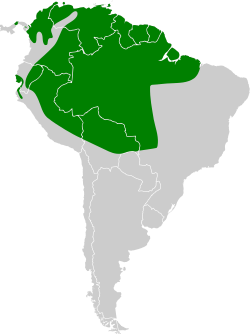From Wikipedia
Open on Wikipedia
| Short-tailed swift | |
|---|---|

| |
| flying over Cristalino river, Mato Grosso state, Brazil | |
| Scientific classification | |
| Kingdom: | Animalia |
| Phylum: | Chordata |
| Class: | Aves |
| Clade: | Strisores |
| Order: | Apodiformes |
| Family: | Apodidae |
| Genus: | Chaetura |
| Species: | C. brachyura
|
| Binomial name | |
| Chaetura brachyura (Jardine, 1846)
| |

| |
The short-tailed swift (Chaetura brachyura) is a bird in the Apodidae, or swift family.
Taxonomy
[edit]The species was first formally described as Acanthylis brachyura in 1846 by the Scottish naturalist Sir William Jardine, based on the observations of Mr. Kirk, a resident of Tobago.[2]
The genus name Chaetura is derived from the Greek khaite (hair) and oura (tail). The specific epithet brachyura is Greek for brakhus (short) and ouros (tailed).[3]
Four subspecies are recognized:
- C. b. praevelox, found in Grenada, Saint Vincent, and Tobago
- C. b. brachyura, the nominate subspecies, found from Panama to Trinidad and the Guianas, south to west-central Brazil and northern Bolivia
- C. b. ocypetes, found in southwest Ecuador and northwest Peru
- C. b. cinereocauda, found in north-central Brazil[4]
The subspecies C. b. ocypetes is sometimes considered a full species, the Tumbes swift Chaetura ocypetes Zimmer, 1953.
Distribution and habitat
[edit]The swift is a common resident of Trinidad, Tobago, Grenada and Saint Vincent, and in tropical South America from Panama, Colombia and the Guianas south to Ecuador, Peru and Brazil; in Brazil, the entire Amazon Basin, excluding much of the southeastern Basin. It rarely occurs over 800 m ASL even in the hottest parts of its range and in mountainous or hilly terrain it inhabits,[5] but has been recorded as high as 1,300 m ASL.[6] It is found in a range of habitats including savanna, open woodland, and cultivation.
Description
[edit]The short-tailed swift is about 10.5 cm long, and weighs 20 g. It has long narrow wings, a robust body and a short tail. The sexes are similar. It is mainly black with a pale rump and tail. It can be distinguished from related species in its range, such as the band-rumped swift (C. spinicauda) or the gray-rumped swift (C. cinereiventris) by the lack of contrast between the rump and the tail, the latter being much darker in the other species.
Behaviour
[edit]It is very gregarious and forms communal roosts when not breeding. Predation by bats at the nest sites has been suspected. The flight call is a rapid chittering sti-sti-stew-stew-stew.
Breeding
[edit]The nest is a 5 cm wide shallow half-saucer of twigs and saliva attached to a vertical surface. This is often a man-made structure like a chimney or manhole, as with its relative, the chimney swift (C. pelagica), but natural caves and tree cavities are also used. Up to seven white eggs (average 3 or 4) are incubated by both parents for 17–18 days. The young leave the nest in a further two weeks, but remain near it, clinging to the cavity wall without flying, for another two weeks.
Feeding
[edit]The swift feeds in flight on flying insects, including winged ants and termites.
Footnotes
[edit]- ^ BirdLife International (2020). "Chaetura brachyura". IUCN Red List of Threatened Species. 2020 e.T22686725A168010927. doi:10.2305/IUCN.UK.2020-3.RLTS.T22686725A168010927.en. Retrieved 12 November 2021.
- ^ Jardine, Sir William (1846). "XV. Horae Zoologicae. No. VIII. Ornithology of the Island of Tobago". The Annals and Magazine of Natural History, Including Zoology, Botany, and Geology. XVIII: 120. Retrieved 15 April 2022.
- ^ Jobling, James A. (2010). The Helm dictionary of scientific bird names: from aalge to zusii. London: Christopher Helm. pp. 76, 98. ISBN 978-1-4081-2501-4.
- ^ Gill, F.; Donsker, D.; Rasmussen, P. (Eds.). "Master Lists – IOC World Bird List 12.1". IOC World Bird List. Retrieved 15 April 2022.
- ^ Laverde-R. et al. (2005)
- ^ Cuervo et al. (2007)
References
[edit]- Chantler, Phil & Driessens, Gerald (2000): Swifts: a guide to the swifts and treeswifts of the world. Pica Press, Mountfield, East Sussex. ISBN 1-873403-83-6
- Cuervo, Andrés M.; Hernández-Jaramillo, Alejandro; Cortés-Herrera, José Oswaldo & Laverde, Oscar (2007): Nuevos registros de aves en la parte alta de la Serranía de las Quinchas, Magdalena medio, Colombia [New bird records from the highlands of Serranía de las Quinchas, middle Magdalena valley, Colombia]. Ornitología Colombiana 5: 94–98 [Spanish with English abstract]. PDF fulltext
- ffrench, Richard; O'Neill, John Patton & Eckelberry, Don R. (1991): A guide to the birds of Trinidad and Tobago (2nd edition). Comstock Publishing, Ithaca, N.Y.. ISBN 0-8014-9792-2
- Hilty, Steven L. (2003): Birds of Venezuela. Christopher Helm, London. ISBN 0-7136-6418-5
- Laverde-R., Oscar; Stiles, F. Gary & Múnera-R., Claudia (2005): Nuevos registros e inventario de la avifauna de la Serranía de las Quinchas, un área importante para la conservación de las aves (AICA) en Colombia [New records and updated inventory of the avifauna of the Serranía de las Quinchas, an important bird area (IBA) in Colombia]. Caldasia 27(2): 247–265 [Spanish with English abstract]. PDF fulltext
External links
[edit]About
No page comments added.Synonyms
- Chaetura brachyura [brachyura Group]
